Fonderie-Miniature 1/48 NORD 1500 “Griffon II”
Hi everyone!
This is my 1/48 Griffon II, done about 15 years ago.
The Nord 1500 Griffon was an experimental ramjet-powered fighter aircraft designed and built in the mid-1950s by French state-owned aircraft manufacturer Nord Aviation. It was part of a series of competing programs to fill a French Air Force specification for a Mach 2 fighter.
Design of the Griffon originated in a late 1940s requirement for a high speed interceptor. Engineers at Arsenal de l'Aéronautique instigated studies into swept and delta wings using supersonic gliders. Results from these flight tests favoured the delta configuration, which was incorporated into design studies using a variety of powerplants. Two prototypes were ordered in 1955, without military equipment for research purposes only.
Constructed mainly of light alloys, the Griffon comprised a large tubular fuselage which supported the middle set delta wings, fin with rudder and the forward fuselage, which extended forwards over the turbo-ramjet air intake. The forward fuselage housed the single-seat cockpit and carried small delta canards on either side of the cockpit. The tricycle undercarriage retracted into the wings and the underside of the air intake.
The design of the Griffon featured a dual turbojet-ramjet powerplant, with the turbojet enabling unassisted takeoffs (ramjets cannot produce thrust at zero airspeed and thus cannot move an aircraft from a standstill) and the ramjet producing extra thrust at airspeeds above 1,000 km/h (600 mph). To reduce risks in using the relatively new turbo-ramjet powerplant, the first Griffon (Nord 1500-01 Griffon I) was completed with only the 3,800 kgf thrust ATAR 101F turbojet component.
First flown by Andre Turcat on 20 September 1955, the Griffon I proved to be underpowered but plans to install the planned ramjet component were never realised. Despite the lack of power the Griffon I still managed to reach M 1.17.[2] Flying with the Griffon I ceased in April 1957 in favour of the ramjet-equipped Griffon II. Visible differences between the two aircraft were limited to the smaller intake and two-position exhaust nozzle of the Griffon I.
After proving the aerodynamic aspects and systems of the Griffon, the 1500-01 was retired in April 1957. Flying continued with the Griffon II after its first flight on 23 January 1957. With Major André Turcat at the controls, the Griffon II reached a top speed of Mach 2.19 (2,330 km/h or 1,450 mph) in 1958, thus proving the soundness of the basic design. However, the aircraft met several technical difficulties, such as kinetic heating, due to the lack of temperature-resistant materials, such as Inconel or titanium, in the parts of the airframe experiencing the highest temperatures. The ramjet was found to work well at high speed, but was unstable at medium speeds.
Production of operational versions, dubbed Super Griffon did not take place as it was found that the requirements could be met and exceeded with less complex and cheaper aircraft such as the Dassault Mirage III.
I bought this rare kit when I was on a mission in France 17 years ago, as I loved the shape and the rarity of this aircraft. It is a typical multimedia FM kit, the main parts done in thick low pressure styrene, many "delicate" parts (cockpit, seat, wells, nose -yes the nose!- etc) cast beautifully in resin, nice white metal gear and the complimentary photoetched fret, which, although nicely done, is not completely appealing to me, as some depictions (elevon pushrods, pitot tubes etc) cannot be succesfully rendered 2-dimensionally with photoetch.
OF COURSE being an FM kit meant it enjoyed the velvet treatment of my bastard file. After a laborious endless circular effort of sandind - errrr, sorry - grinding, testing, then sanding-testing-sanding...gluing-filling etc etc the result was attributed acceptable (dear Penlight Police, please do not get very close to the intake!) The detail in the cockpit and the wheel wells is very good indeed!
I didn't do any multishading, which would be nice, but I was not into this technique back then.
The decals performed beautifully with no issues whatsoever.
So here she is! "Beauty lies in the eyes of the beholder", but I guess few will say that the Griffon is not beautiful.
Not a kit for a beginner. As usual (!), I loved putting it together.
Happy modelling!

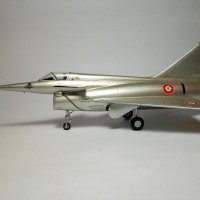
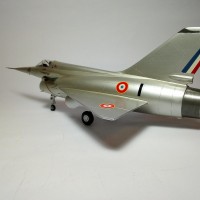
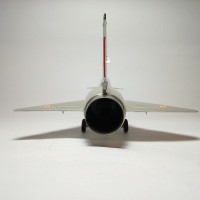
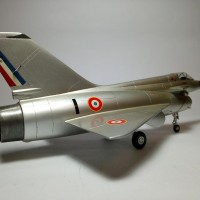
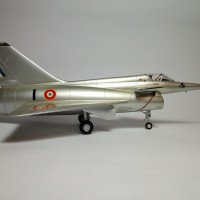
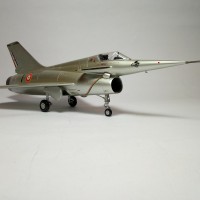

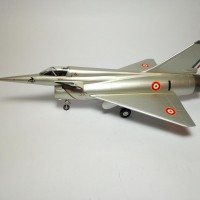
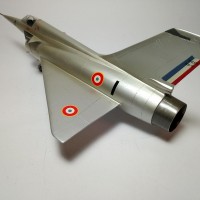

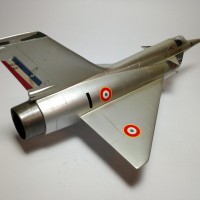

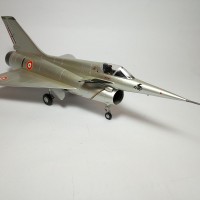
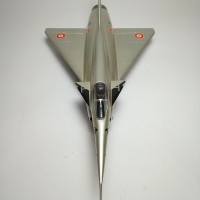
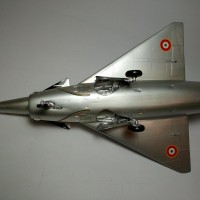
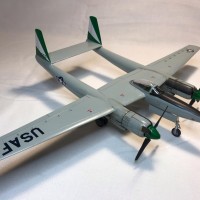
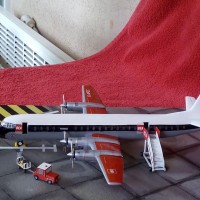
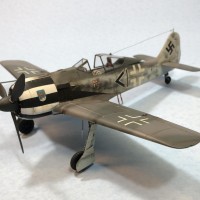
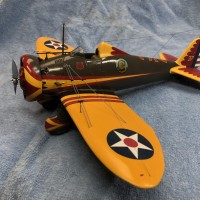
STUNNING! This is a winner! Well done!
Thank you Morne!
I have heard that this is a rough kit to build so bravo on it turning out so well. I like the look because it appears to be the parent of the F-16 Viper.
I was going to say the same!
Thank you Dan and Josh!
Great work on a great subject, Spiro! The perfect companion for your Grognard. You might be the only person who has completed two FM kits.
Thanks John! Kudos to my bastard file!
Gorgeous looking jet, very Mirage-esque. I'm off to youtube to see if there any decent docs on it for my nightly in bed plane viewing!
Thanks Jimmy! Definitely an ancestor of Mirage, struggling to find sufficient power to make good use of THAT design. Also, ill fated due to the fact that it was designed at the period where ramjets were under considerable thought for use in "normal" fighters. When designers lost hope at the ramjets, one can argue that promising designs like the Griffon were simply left aside.
All the best, my friend @hetstaine!
Cool looking subject and great job. Fonderie kits are pretty crude and you did well in making it look good.
Thanks Dale!
Proof that you can turn a sows ear into a silk purse. Very well done.
Thank you Haslam!
Nice to see this rare bird, great job!
Thanks Robert!
Weird looking bird. You did a great job. Looks fantastic.
Thanks a lot, John!
That is really pretty, and something I have never seen. It definitely has the experimental look of a lot of planes from the 50's. Great job!
Thanks Walt!
Spiros: What a sweet build, of a very unusual subject. Great job, on a very unique model.
Thank you very much, Marvin!
bad-as
Thanks Bob!
I've never heard of this aircraft before but I will check it out, great job on what sounds like a difficult kit Spiros I really like it.
Thanks Neil! It is amazing to discover such great oddities!
"Not a kit for a beginner" - that should be on the boxtop of every F-M kit!
Great work, Spiros. It looks both advanced and "quintessentially French" at the same time.
"If it's weird it's French!" Thanks for appreciating Tom.
Spiros, I can only echo what has been said. What a fantastic machine, and a build to match! Thanks for sharing this beautiful work!
Thank you Paul! Glad you like it!
Interesting subject and a great build!
Well done!
Thanks Tommy!
Wow, a dart with a huge exhause pipe. I like it, well done Spiros.
Spot-on description, Tom. Thanks for liking!
What a strange looking bird that is! Although it does indeed look like a flying exhaust pipe with a dart nose, it’s intriguingly attractive. Superb paint finish. Glad you posted it.
Thanks Eric!
Really interesting project, Spiros. That applies both to the abandoned ramjet fighter design and your lovely model. I didn't realize that the French had a project like this. It reminds me of the experimentation in the UK around the same time with rocket augmented power and other innovations. You have got the best possible result on a difficult kit. Great NMF and decaling.
Thanks very much Colin @coling! The French had quite some interesting rocket projects that actually flew, the Leducs being the most bizarre among them, as you may observe at the pics below. Can you imagine flying in THAT cockpit? "If it's weird, it's French" indeed.
All the best!
4 attached images. Click to enlarge.
Nicely done! That is one strange-looking bird, but you created a very interesting model, and did so really well.
Thanks a lot, my friend!
Wow, what an unusual-looking aircraft; great work, Spiros!
Thanks @RRman! Strange planes from "strange-but-lovely" days indeed.
All the best!
I'm a bit late to the party but, great job.
I can remember seeing pictures of this aircraft years ago and it is great to see a kit of it, and one that is built so well.
I am even later in answering, my friend Michael @michaelt! Just discovered your comment by randomly searching my blog...oh dear!
I remember my excitement when I was on a mission in in France, back in 2003, and discovered this kit at Maurice-Verdeun hobby shop in Bordeaux, together with many other hard to find kits (like the 1/48 Grognard, the Breguet 693 etc!).
I had to get them and build them! It was back then that I had decided to seriously re-enter the hobby, by buying an airbrush and other "professional" tools.
So, dealing with - and finishing! - seriously limited run kits, like F-M, would boost my self confidence!
Got some F-M still unbuilt, the 1/48 Halifax included!
Thanks a lot for the kind comments, my friend!